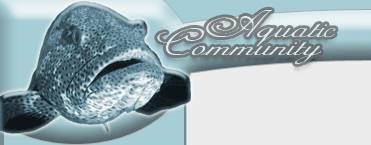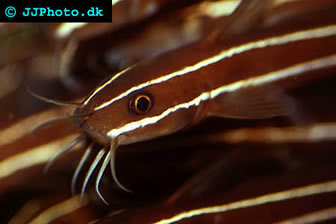Striped Eel Catfish
Plotosus lineatus
Common name: Coral Catfish, Marine Catfish, Striped eel Catfish
Scientific name: Plotosus lineatus
Max size: 12 in / 30 cm
pH: 8.1-8.6
Salinity: 1.023-1.025
Temperature: 68-81ºF (20-27°C)
The Striped eel catfish is an interesting schooling fish. Juvenile specimens live in large schools with 100s of fish in them, while adults live in smaller groups. In an aquarium you should keep at least a small group; never keep a Striped eel catfish alone without other Striped eel catfish present. This is the only species of catfish that lives on coral reefs.
The Striped eel catfish has a dark brown body with lighter colour on the underside. The juveniles have very striking white stripes along their bodies. These strikes are less pronounced or even gone completely in adult specimens. For a better grasp of how Striped eel catfish look you can look at the pictures on this page. The pictures portray young specimens.
Handle Striped eel catfish with care as the first dorsal and each of the pectoral fins can inject a highly venomous toxin in you if you are not careful. The toxin can cause severe pain or, if you are unlucky, even death. (Deaths are however rare.)
The Striped eel catfish is not reef safe even though it is found on reefs in the wild. They may eat small fish and invertebrates. They do however usually not damage corals if there are no small fish present. If there are small fish present they might unintentionally damage the corals when they try to catch the small fish.
Striped eel catfish should only be kept in saltwater but can survive freshwater for shorter periods of time. This has lead to fish stores sometime keeping them in freshwater and even selling them as freshwater fish. They are however not freshwater fish and will not live long in freshwater. Most specimens kept in freshwater dies within months. The fact that Striped eel catfish can tolerate freshwater for shorter period of time can however make it easier to treat marine diseases that die in freshwater.
The Striped eel catfish originates in the Indian and Pacific Ocean. They can be found from the Red Sea, the coast of East Africa and as far east as Australia, Lord Howe Island, Palau and Japan.
This species is relatively friendly towards fish that are too big to eat and the Striped eel catfish can be kept with most other fish species that are too big to be considered food.
Striped eel Catfish care and aquarium setup:
Since this species grow large and should be kept in groups you will need a large aquarium to house them in. I recommend 100 gallon / 450 L as an absolute minimum for keeping this species and would personally not keep a group of Striped eel catfish in an aquarium smaller than 250 gallon / 1000 L. The aquarium should be decorated so that the fish can find enough caves and other hiding places. Corals can be used in the setup but are not required. The bottom should be covered with sand or coral rubble.
This species prefers a well lit aquarium with some darker spots to rest in. An aquarium housing Striped eel catfish should be well circulated with some calmer areas. They can be kept in "fish only" and "fish with live rock" tanks but are not completely suitable for reef setups.
Feeding Striped eel Catfish
The Striped eel catfish is very easy to feed if you take into account that they are bottom feeders and that you have to make sure that enough food sinks to the bottom of the tank for them to eat (without overfeeding). They will accept just about every type of food conceivable including flake food and marine pellets. Try to give them a varied diet and give them a treat like live food, frozen food or chopped up sea food every now and then.
Breeding Striped eel Catfish
Little is known about breeding the Striped eel catfish in aquariums. In the wild they spawn during the summer months. The male digs a nest in the bottom, usually in a shallow rocky area. He then tries to entice a female to the nest to mate with him. The male striped eel catfish guards the eggs. The eggs are small. If you want to try to breed striped eel catfish in an aquarium you will likely have to try and mimic the conditions in which they breed in the wild.

